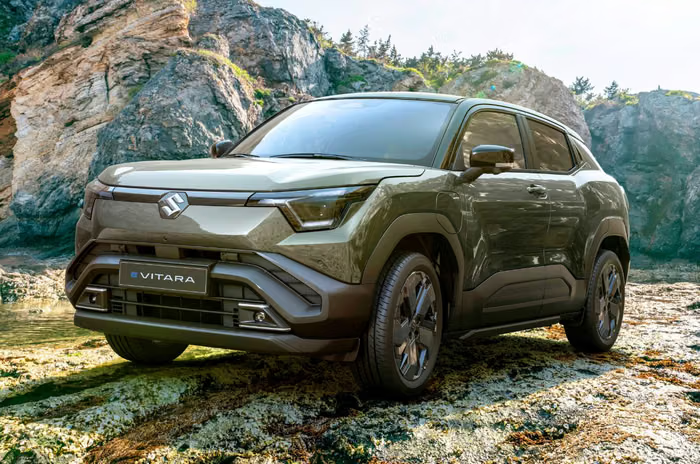Prime Minister Narendra Modi on August 26, 2025, launched a new chapter in India’s automotive journey by inaugurating the production of the Maruti Suzuki e Vitara, the country’s first globally manufactured electric SUV at the Hansalpur plant in Gujarat. This historic moment marks India’s transformation into a global hub for electric vehicle manufacturing and showcases the strength of the “Make in India” initiative.

Historic Launch and Global Significance
The launch ceremony at the Suzuki Motor Plant in Hansalpur represents a major milestone for Indian manufacturing. Prime Minister Modi personally flagged off the e Vitara, which will be exported to over 100 countries including Japan and European markets. This makes India Suzuki’s global manufacturing center for electric vehicles, demonstrating the country’s capability to produce world-class automotive technology.
The e Vitara is Suzuki’s first global strategic Battery Electric Vehicle (BEV) and represents years of careful planning and customer research across key markets. The vehicle first made its public appearance at the Bharat Mobility Global Expo 2025 in January before moving to commercial production.
Technical Specifications and Performance
Battery and Powertrain Options
The e Vitara offers two comprehensive battery configurations designed to meet diverse customer needs:
49 kWh Battery Variant:
61 kWh Battery Variant:
- Power output: 172-174 bhp
- Torque: 189-192.5 Nm
- Range: Over 500 km on single charge
- Acceleration: 0-100 kmph in 8.7 seconds
Both variants use Lithium Iron Phosphate (LFP) battery chemistry supplied by BYD, which offers enhanced safety and longer battery life with over 20,000 charge-discharge cycles. The batteries are designed to perform in extreme conditions ranging from “Sand to Snow” temperatures.
Charging Technology
The e Vitara features advanced charging capabilities:
- DC Fast Charging: 61 kWh version charges from 0-80% in 45-50 minutes
- AC Charging: Available with smart home charger options
- Charging Port: CCS-II standard for compatibility
Comprehensive Feature Package
Design and Exterior
The e Vitara adopts a bold and masculine SUV styling that differs from typical sleek electric vehicles. Key exterior features include:
- 18-inch aerodynamic alloy wheels with aero covers
- Y-shaped LED DRL signature integrated with headlights
- Muscular body cladding and healthy ground clearance
- Hidden rear door handles for modern aesthetics
- Connected LED tail lamps with Y-shaped insignia
Color Options: The SUV is available in 10 exterior colors including Opulent Red, Bluish Black, Arctic White, Grandeur Grey, Splendid Silver, Nexa Blue, and Land Breeze Green. Four colors can be paired with a contrasting Bluish Black roof for dual-tone variants.
Interior and Technology
The e Vitara’s cabin represents a complete departure from traditional Maruti design philosophy:
Digital Cockpit:
- 10.25-inch touchscreen infotainment system
- 10.1-inch digital instrument cluster
- Integrated Display System with Twin-Deck Floating Console
Premium Comfort Features:
- 10-way power-adjustable driver seat (first for Maruti)
- Sliding and reclining rear seats
- Ventilated front seats
- Premium Infinity by Harman 10-speaker sound system
Advanced Connectivity:
- Next-Gen Suzuki Connect with over 60 features
- Wireless Android Auto and Apple CarPlay
- Multi-color ambient lighting
- Wireless phone charger
Safety and Driver Assistance
The e Vitara introduces Maruti’s first Level 2 ADAS system in India, featuring:
Advanced Driver Assistance:
- Adaptive Cruise Control
- Lane Keep Assist
- Adaptive High Beam System
- Blind Spot Monitoring
- Active Cornering Control
- Multi-Collision Braking
Safety Equipment:
- 7 airbags as standard (including driver knee airbag)
- 360-degree camera system
- Electronic Stability Control
- Electronic parking brake with auto hold
- Tire Pressure Monitoring System (TPMS)
- Emergency Call with SOS button
Market Position and Pricing
Expected Pricing Structure
The e Vitara is expected to be positioned competitively in the premium electric SUV segment:
The SUV will be available in three variants: Delta, Zeta, and Alpha, with the smaller battery pack likely limited to the base variant.
Official Launch Timeline
While production began on August 26, 2025, the official India launch is scheduled for September 3, 2025. The vehicle will be sold through Maruti’s premium Nexa dealership network across the country.
Competitive Analysis
Direct Competitors
The e Vitara enters a growing electric SUV segment with several established rivals:
| Specification | Maruti e Vitara | Hyundai Creta Electric | Tata Curvv EV | MG ZS EV |
|---|---|---|---|---|
| Price Range | ₹17-22.50 lakh* | ₹17.99-24.38 lakh | ₹17.49-22.24 lakh | ₹19-26 lakh |
| Battery Capacity | 49/61 kWh | 42/51.4 kWh | 45/55 kWh | 50.3 kWh |
| Range | 500+ km | 390-473 km | 430-502 km | 461 km |
| Power | 142-172 bhp | 133-169 bhp | 148-165 bhp | 177 bhp |
| Charging Time | 45-50 min (10-80%) | 58 min (10-80%) | 40 min (10-80%) | 56 min (10-80%) |
| Airbags | 7 (standard) | 6 | 6 | 6 |
Key Competitive Advantages
Superior Range: The e Vitara’s 61 kWh variant offers the longest range in its segment at 500+ km, addressing range anxiety concerns.
Advanced Safety: First Maruti with Level 2 ADAS and 7 airbags as standard across all variants.
Premium Audio: 10-speaker Infinity sound system compared to 8-speaker systems in rivals.
Larger Wheels: 18-inch alloy wheels provide better road presence compared to 17-inch wheels in most competitors.
Battery Ecosystem Development
TDS Lithium-Ion Battery Plant
A significant part of today’s inauguration was the commencement of hybrid battery electrode production at the TDS Lithium-Ion Battery Gujarat plant. This facility represents a joint venture between three Japanese giants:
- Toshiba Corporation (40% stake) – Cell Technology
- Denso Corporation (10% stake) – Module Technology
- Suzuki Motor Corporation (50% stake) – Manufacturing Expertise
Localization Impact
The battery plant’s activation ensures that over 80% of battery value will now be manufactured within India. This development significantly strengthens India’s electric vehicle ecosystem and reduces import dependency. The facility has a production capacity target of 30 million cells per year by 2025.
Investment Scale
The total investment in the battery manufacturing facility spans ₹4,930 crore across two phases:
‘e for me’ Charging Infrastructure
Maruti Suzuki has announced a comprehensive charging ecosystem called ‘e for me’ to support e Vitara owners:
Infrastructure Rollout:
- Fast DC chargers at Nexa dealerships in top 100 cities
- Smart home chargers with remote access capability
- Plug-and-play fast chargers for convenient charging
Service Network:
- Over 1,500 EV-enabled service outlets across 1,000+ cities
- Specially trained technicians for EV maintenance
- Dedicated ‘e for me’ app for charging network management
Global Export Strategy
Manufacturing Hub Status
The Hansalpur plant positions India as Suzuki’s global manufacturing center for electric vehicles. The facility operates with an annual capacity of 2.6 million units across four Indian plants, with Maruti Suzuki already exporting 3.32 lakh vehicles in FY25.
Export Markets
The e Vitara will reach over 100 countries including:
This export strategy demonstrates India’s manufacturing quality meeting international standards and positions the country as a competitive EV production hub.
Economic and Strategic Impact
Make in India Success Story
The e Vitara project exemplifies the success of the Make in India initiative in high-technology manufacturing. Prime Minister Modi emphasized this as “a special day in India’s quest for self-reliance and being a hub for green mobility”.
Employment Generation
The combined automotive and battery manufacturing operations are expected to create:
- Direct employment in manufacturing operations
- Indirect employment in supplier ecosystem
- Skilled workforce development in EV technologies
Technology Transfer
The collaboration brings advanced Japanese technology to India while building local capabilities in:
Environmental and Sustainability Goals
Carbon Emission Reduction
The e Vitara supports India’s commitment to net-zero carbon emissions by 2070 through:
- Zero direct emissions during operation
- Renewable energy integration potential
- Reduced fossil fuel dependency
Sustainable Manufacturing
The production facilities incorporate:
- Solar power generation of 1 megawatt at TDSG plant
- Extensive green cover in manufacturing premises
- Environmental stewardship principles
Market Outlook and Future Prospects
EV Market Growth
With electric vehicles currently representing just 3% of car sales in India, the e Vitara is positioned to accelerate EV adoption while establishing Maruti’s presence in the electric segment.
Technology Roadmap
The e Vitara platform (HEARTECT-e) is designed for future expansion, potentially supporting:
- Additional battery configurations
- All-wheel drive variants for global markets
- Enhanced autonomous driving features
Conclusion
The launch of the Maruti Suzuki e Vitara on August 26, 2025, marks a transformative moment for Indian automotive manufacturing. By combining advanced technology, comprehensive features, competitive pricing, and global export ambitions, the e Vitara positions India as a serious player in the global electric vehicle market.
The simultaneous inauguration of battery electrode production demonstrates India’s commitment to building a complete EV ecosystem rather than just assembly operations. With over 80% battery value now manufactured domestically, India moves closer to true self-reliance in electric mobility.
The e Vitara’s impressive 500+ km range, advanced safety features, and competitive pricing make it a compelling choice for Indian consumers while its export to over 100 countries showcases Indian manufacturing excellence on the global stage. As India accelerates toward its clean energy goals, the e Vitara represents both the present achievement and future potential of the country’s electric vehicle revolution.
This launch not only fulfills Prime Minister Modi’s vision of “Make in India for the World” but also establishes a foundation for India’s leadership in sustainable transportation technology for decades to come.
